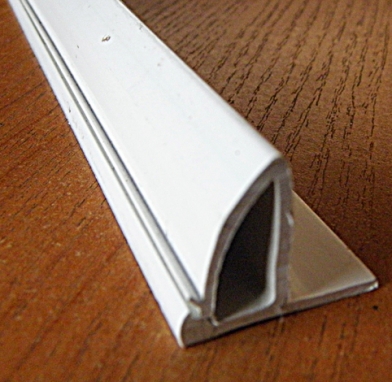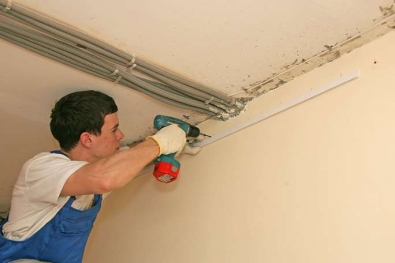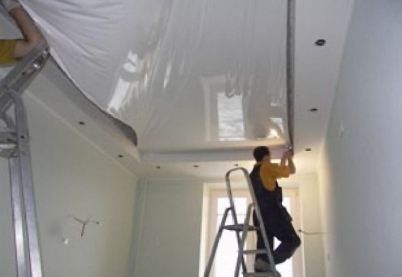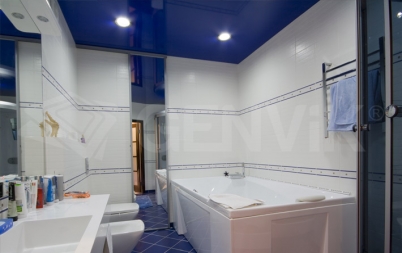In order to ensure ventilation in the bathroom, the threshold is built. Threshold in the bathroom or in ...
|
|
During a thunderstorm, in order to improve the safety of home and people who live there, ... |
Before you start installing windows on the loggia, you need to decide on their model and ... |
Installation of a stretch ceiling in the bathroom
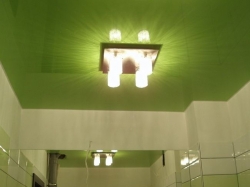
A neat well -groomed ceiling is the key to a pleasant external appearance of any room. The choice of ceiling coating is especially complicated for wet rooms with high temperature, such as a bathroom where, in addition to aesthetic requirements, the ceiling should also correspond to functional. Stretch ceilings in the bathroom, photos of which can be viewed below, combine aesthetic attractiveness and practicality. And the installation of a stretch ceiling in the bathroom is not a simple, but fascinating activity that may turn into your hobby. Having once mounted the ceiling at home, you will certainly want to help others in this.
Table of contents:
- The advantages of stretch ceilings
- Disadvantages of stretch ceilings
- Tool for work
- Ways to attach a stretch ceiling
- Stages of installation
The advantages of stretch ceilings:
- Corrosion resistance and decay. No matter how wet the room may be, rust or mold will never appear on the canvas
- Lack of cracks. The canvas is so plastic that the cracks characteristic of standard white ceilings will not occur even with a significant shrinkage of the house or earthquake.
- Fire resistance. PVC is not a flammable substance, and does not support combustion in case of fire.
- The ability to hold large volumes of water. If you are suddenly flooded by neighbors from above, the ceiling will not burst. One linear meter of the stretch fabric can withstand up to 100 liters of water. Then it will be possible to pump it out either through a small hole or through the pipe, if it was laid specifically for these purposes during installation.
- The stretch ceiling in the bathroom does not get wet. Even if you spray it on it or your neighbors will occasionally flood you, the water -repellent material of the PVC ceiling will retain its original appearance without stains and subtexts.
- PVC ceiling does not collect dust. It is electrically neutral, unlike other materials, due to which dust particles do not stick to the canvas. This allows the use of PVC-forth in medical rooms that have high requirements for cleanliness.
- It does not fade and does not fade in the sun.
- It withstands a fairly wide range of temperatures, without changing the properties and external characteristics depending on the season.
- Environmental friendliness. Of course, PVC film is not a natural tree, but not plastic. It does not have a positive effect on a person, but does not distinguish anything toxic. Chemically polyvinyl chloride is absolutely stable, does not enter into chemical reactions with the release of substances. The fabric stretch ceiling is more natural than PVC, but it is not suitable for the bathroom.
- A wide selection of color solutions and design options. Fabric stretch ceilings are performed even with photo printing, they can be designed in any style for any interior. For the bathroom, for example, a sea or aquarium theme is suitable. The translucent fabric for the ceiling makes it possible to arrange the backlight under it, creating the effect of the starry sky.

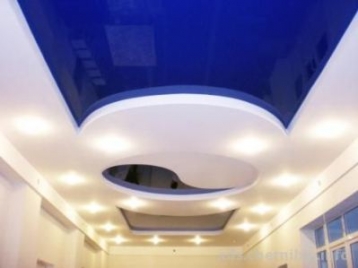
- The possibility of visual expansion of the space due to the glossy of the surface of the stretched canvas.
- Lack of the need to prepare the surface for work. The canvas hides waves and the wrong relief of the ceilings. Pipes, wiring and other communications can also be conveniently hidden under the canvas without delving into concrete.
- The height of the ceiling is reduced by only 2-3 cm. This value, of course, largely depends on the evenness of the ceiling floors: the more even the original ceiling, the less you have to retreat under the stretch. But, compared with the ceiling from siding or drywall, where you need to retreat all 10 cm, 2-3 cm is a very insignificant loss.
- Easy to care. You can wash any dirt with an ordinary wet cloth without cleaning products.
- Durability. The service life of such a ceiling is not limited, the guarantee for it is 10 years.
- Easy dismantling. Agree that it is much easier to remove the stretch ceiling in the bathroom than to shoot down a plaster that can damage the plumbing. If you ever decide to update the coating, you can do it without the help of builders.
Disadvantages of a stretch ceiling:
- It is easy to damage with sharp objects. If you inaccurately touch the canvas with the edge of the door during installation or furniture during rearrangement, you can seriously damage it. Then you will have to call the master for repair. That is why it is necessary to pull the ceiling at the very end of the repair, when the probability of its damage is small. The most bulky and high furniture is also better to be brought to the room before installation.
- Low resistance to temperatures below minus 20 degrees. Therefore, it is better not to mount a stretch ceiling from PVC on the balcony or veranda.
- A fairly high cost. In principle, it is justified by a long service life and a lot of positive functional and aesthetic characteristics. But still, if you decide to install a stretch ceiling in the bathroom, its price is higher for the suspended ceiling from siding or PVC panels.
- The exactingness of the cleanliness of the room during installation. Although the film is easily washed, it is better not to dirty it again, especially with construction garbage, which, in addition, can have sharp edges and damage the canvas. Taking a three- or five-meter ceiling canvas is not so simple that it does not touch the floor, so it does not hurt to clean up.
Work tool:
Any business man has all the necessary tools except, perhaps, of the heat gun. This is a punch for making holes in the profile, dowel and screws for its fastening, a conventional roulette and a building level for installing the profile clearly horizontally. You will also need a screwdriver, a metal hacksaw for cutting a profile and a stepladder. A construction transporter for measuring the angles of the room and a mounting gun for working with sealants will not hurt. To refuel the PVC, you will need a special spatula in the profile groove, and a construction hairdryer will need a building hair dryer.
As for the gun, it can be rented in a construction store or lend from familiar builders. But be careful, because With non -compliance with the rules for using a gas gun, it can explode. The necessary power of the gun is calculated by the area of \u200b\u200bthe room, which needs to be heated. For a middle bathroom, a gun with a capacity of 50 kW is suitable.
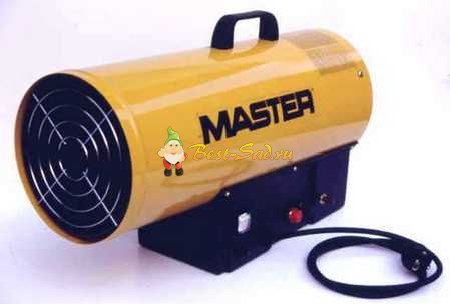
If you plan to install a stretch ceiling in the bathroom with your own hands, ask someone to assist you, so as not to go down every tool from the stepladder down. Or purchase a mounting belt for which you can conveniently plug all the necessary improvised tools.
Ways to attach a stretch ceiling
Since the fabric ceiling is not suitable for the bathroom, consider the methods of attaching a stretch fabric from PVC:
- Harpoon (French). Along the perimeter of the canvas there is a noticeable thickening of flexible plastic in the form of a harpoon. This harpoon is tilted into an aluminum profile with a spatula. This species is considered the most reliable.
- Helper (Dutch). In this case, the edges of the canvas are not processed, but it is attached to the profile due to the inserted wedge or special fists that hold the canvas, preventing it from jumping out. This method is more time -consuming, but allows you to make a minimum indentation from the black ceiling, as well as regulate the strength of the ceiling tension.
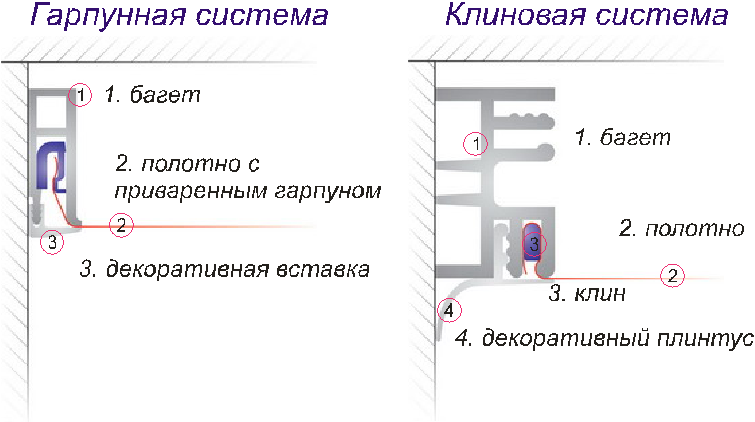
For a harpoon method of fastening, the size of the canvas should be 7% less than the size of the room so that it is well stretched. And the dimensions of the canvas for non -harpoon fasteners should be calculated with a margin of 15 cm so that it is convenient to fix it. The excess at the end is simply cut.
Stages of installation:
- Remove the dimensions from the bathroom: length, width and angles using the transporter.
- We mark the walls with a level. To do this, we retreat from the lowest point of the native ceiling at least 4 cm. We draw along the perimeter of the line for fastening the profile.
- We measure the desired length of the profile and cut it with scissors for metal. The ends of the profile are cut at an angle equal to half the corner of the room. Thus, the profiles should be exactly fixed with each other.
- We fasten the profile for dowels and screws.
- We heat the room with a heat gun to a temperature of 40 degrees. Turning the canvas, evenly heat it along the entire length.
- We fasten the ceiling, starting from the base corner, it is marked on the canvas. Then we install the opposite angle, then the other two. Only after that we proceed to the mount in the center of the walls, and then around the entire perimeter.
- When the ceiling is completely fixed, smooth the folds with a heat hairdryer, and install a decorative plug, masking the connection.
Stretch ceilings in the bathroom, the video about which can be seen below, can be installed even by one person, the main thing is to plan all the stages of work in advance, choose the necessary tool and clearly measure all consumables.

